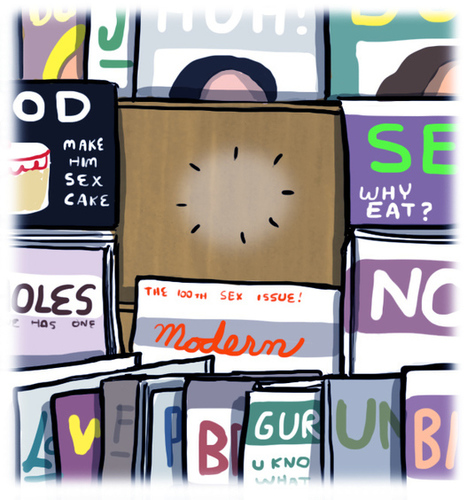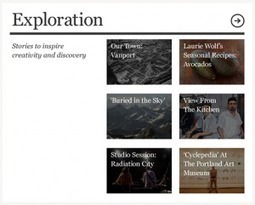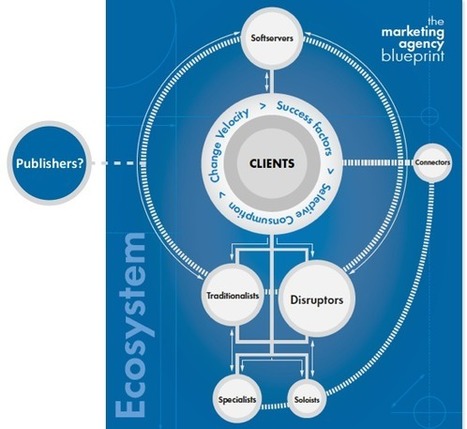 Your new post is loading...
 Your new post is loading...
Today it was revealed that Vox Media, owner of The Verge, SB Nation, and Polygon has raised another $40 million of funding.
...But bigger exits are emerging: There was Huffington Post and Bleacher Report. There’s that Vice valuation. And even Swisher and Mossberg without a site are rumored to be in the $30 million valuation size — bigger than what TechCrunch sold for after six years. A pattern is forming.
The investments in Buzzfeed and Vox in particular show that well-heeled investors believe that new media can be more than just profitable lifestyle businesses buoyed by non-scalable event franchises. These guys are betting there are big public companies here.We’re seeing the same kind of transition with content that we saw with the early Web 2.0 companies like Delicious and Flickr. They sold out cheap at first as projects morphed into companies and then the next generation thought bigger....
Does this signal the beginning of the end for Forbes as a knowledgeable source of business information? Have they finally "jumped the shark" on their way to the exit? "Jumping the shark" is actually an expression that goes back to the TV sitcom series, Happy Days. It was a show that pictured everything as rosy and happy, with neat little endings that were all nicely tied up in twenty-two minutes. The chief influencers on that show were "The Fonz," who only had to give you a look to let you know you were in trouble, and Mr. Cunningham, who set down the rules of the family.
In the midst of its ten-year run the writers must have gotten tired or were negatively influenced by the Hollywood decision-makers, when they inexplicably decided to have their characters travel to Los Angeles. Well, one thing leads to another and Fonzie ends up responding to an assault on his courage by taking to water skis (wearing his leather jacket of course) and jumping over a shark.
The stunt was so ridiculous and out of character that "jumping the shark" eventually came to be known as the moment when a television show begins a decline that is beyond recovery. While Happy Days bravely soldiered on for a few more years, it was never really the same in the minds of viewers and critics. Since that time the meaning has been broadened to define the moment when a brand or creative effort begins to lose the qualities that initially defined its success. Some still refer to "New Coke" as the moment when the Coca-Cola Company jumped the shark....
Traditional journalists probably won't like a lot of how Upworthy's become one of the fastest growing aggregators on the web. But it's hard to question the effectiveness of its methods.
Back in November, the Lab’s own Adrienne LaFrance wrote a number of words about Upworthy, a social packaging and not-quite-news site that has become remarkably successful at making “meaningful content” go viral. She delved into their obsession with testing headlines, their commitment to things that matter, their aggressive pushes across social media, and their commitment to finding stories with emotional resonance.
Things have continued to go well for Upworthy — they’re up to 10 million monthly uniques from 7.5. At the Personal Democracy Forum in New York, editorial director Sara Critchfield shared what she sees as Upworthy’s secret sauce for shareability, namely, seeking out content that generates a significant emotional response from both the reader and the writer....
... Scribble’s traction is international; its ScribbleLive real-time content creation and distribution platform is available in 14 languages and used by the biggest media brands, including the Associated Press, Reuters, CNN and ESPN to name a few. I spoke with Scribble CEO and co-founder Michael De Monte about the raise, and his vision for the company.
He pointed out that Scribble recently launched ScribbleMarket, a way for brands to easily syndicate their live content, and to find said content from other sources for use on their own site. Licensing can be free or paid, and this lets news agencies quickly leverage their reporting resources for additional income streams, by providing not just static articles for syndication as has been the case, but full-featured, interactive real-time content that’s being dynamically updated from a single backend.
quiet“The marketplace for us is the exciting component of what we’re building,” De Monte said. “This opportunity to share content in real time, becoming like the iTunes of real-time content has a lot of potential to change the face of media.”...
One of the first things that crops up in conversation these days is the language of digital. The word content is over-used by marketers and publishers. The term does a disservice to the creative process behind it. I find it quite hard to think of stories as content – it’s so far removed from what it takes to do. In the digital age, journalism is still – just – clinging on by its fingernails and using the catch-all moniker of content is not helping its standing. Content covers all players, from finely honed pieces by professional journalists and commentators, to rants by amateurs. However, just because everyone now has access to a publishing platform online, doesn’t meant quality editorial is a dying art, nor does it mean that those producing quality editorial should ignore the changes happening in the publishing world. On a site like xoJane – to which I contributed to for a short stint – you’re trying to connect with people. You’re no longer handing down stone tablets for them to read. I think that’s a very important – and good – part of what’s happened to communication....
|
Digital magazine publishing is increasingly within reach for all kinds of content creators — big, small, non-profit, for profit. As another way to reuse existing content and reach audiences, digital magazines might especially appeal to non-profit and public media news organizations.
At least two such organizations — ProPublica and Oregon Public Broadcasting — have launched free digital iPad magazines to showcase their reporting. The magazines are a low-cost way to gain exposure for their work because they repurpose existing digital content into a new storytelling medium. These organizations’ creative use of digital magazines shows how versatile digital magazines are, and early reactions to the publications suggest the experiments may be a success....
Handheld devices such as mobile phones and tablets are on track to become the dominant platforms for news consumption, and more people are using more than one device, a survey of media consumption habits in nine countries has found.
“News is becoming more mobile, more social, and more real-time,” according to the recently released Reuters Institute Digital News Report 2013: “Tracking the Future of News,” an annual survey which monitors the transition to digital media. “The overwhelming message is that audiences increasingly expect news that they can access anytime, anywhere."
While the survey found the computer remains the primary device for accessing digital news, a third of respondents reported getting news on at least two devices, and 9 percent said they use more than three. Tablet usage doubled in the 10 months since the last survey....
...The company is finding that the most popular content for tablets depends on the title. Golf Digest sees great success with video. Generally speaking, long-form editorial content like actual stories, video and slideshows do well across the board because the tablet is a lean-back device, where consumers aren’t looking for short snippets of content like they are on a mobile phone, for example.
“If you look at the time of day with highest tablet usage it’s usually during prime time or on the weekends,” Reynolds said. “That’s why we are developing tablet-specific content to fit that different mindset. We’re not worried about tablet usage cannibalizing Web usage because Web, tablet and mobile, are all part of a complementary ecosystem.”
Reynold’s said that the biggest opportunity for Conde Nast in the tablet space is the amount of data is has on subscribers. It gives the publisher a look at the preferences that people have for content and advertising on specific devices and Conde Nast can optimize based on that.
Film stars are no longer the reader magnets they once were, so magazines are turning to TV actors, reality stars and musicians. Pity the poor Hollywood film stars: they can’t open movies the way they used to and now they can’t sell magazines. Even a few years ago, the prize for a magazine editor was in luring an A-list Hollywood star onto the cover. But just as much critical attention has shifted to television from theatrical releases, readers are now more likely to pick up a magazine featuring a television actor, reality star or musician. “There was a day when movie stars were the gold standard for magazines,” said Jess Cagle, the managing editor of Entertainment Weekly, where the frequency and sales of TV-oriented covers are catching up with film covers. “But movie stars are less revered than they used to be, and also audiences have shifted their allegiance in large part to television.”
Brands are becoming publishers, but do publishers have untapped opportunities as marketing agencies? ...Rather than viewing content marketing as their impending doom, publishers should be focused on the emerging opportunities: Create and distribute content, in and out of network.Produce sponsored content (aka native advertising).Tap existing advertising partnerships, and even consider cannibalizing their advertising business in favor of a more sustainable future.Offer integrated services (i.e. content + SEO + social + PR + email + analytics). Content alone isn’t enough. As Andrew Davis (@TPLdrew), author of Brandscaping, said in a recent Marketing Agency Insider post, “Publishers are masterful content creators, and they are able to charge a premium for the services they offer by leveraging theirmarket research, existing distribution platforms, and even the talent from their editorial teams.”
And Paul Rossi (@economistrossi), managing editor of The Economist, states on Digiday, "The opportunity for media companies is to create content that’s compelling for users on behalf of advertisers. That doesn’t mean it has to be native, but the skills in telling stories are quite valuable to marketers as they build audience themselves."...
|



 Your new post is loading...
Your new post is loading...



















Content is getting both cash and credibility from the market as investors scramble to bet on which digital content and news media startups will be the next big money maker. Bring it on!